A digital transformation can be a source of fear and anxiety, especially because they require significant investments of time, money, and effort. Not to mention, digital transformations necessitate a migration from something old to something new and unknown. This generates concerns about what will happen to the company and the information it holds.
For example, when looking for new CLM software, many businesses hesitate out of fear, whether it’s the migration itself or uncertainty about what will happen to their existing contracts. It makes sense if you think about it. Each company has tons of sensitive documents and nobody wants to lose something important during the migration process.
It’s just like moving to a new apartment. You want to take all your belongings with you, but you also have to make sure there’s enough storage space for everything you own.
When looking for new CLM software, many businesses hesitate out of fear, whether it’s the migration itself or uncertainty about what will happen to their existing contracts.
The same holds true for contract lifecycle management software. To offer room for growth, scaling processes, and multiple workflows, CLM platforms must be capable of handling all existing contracts. None of your previous work needs to be disregarded or left behind.
AXDRAFT’s CLM system treats legacy contracts with as much care as it does for native contracts on the platform. The only difference is that you don’t draft a document within AXDRAFT. You upload it instead. After adding the necessary data about the document, all functions will just be like those for newly created contracts. In other words, it’s a convenient contract lifecycle management solution that unites all document processes under one roof.

The problem
According to a survey, 25% of lawyers store contracts in desk drawers and filing cabinets, and 35% store them in multiple locations (including different folders on computers and emails). Additionally, 26% of them missed at least one renewal during the year. Storing contacts this way reduces the visibility of agreements and may result in breaking deadlines and obligations. Failing to track renewal or termination dates may incur additional expenses.
For example, if you’re a supplier of products to a particular grocery store, you might keep supplying them according to an agreement that no longer exists. And if you’re a big supplier with hundreds of clients, how would you keep track of each contract if they’re all stored in different places? Besides, upcoming dates for renewal or termination are a good opportunity to renegotiate unfriendly terms.
Just imagine you’re the poor individual whose responsibility it is to oversee contracts that are scattered all over. Crazy!
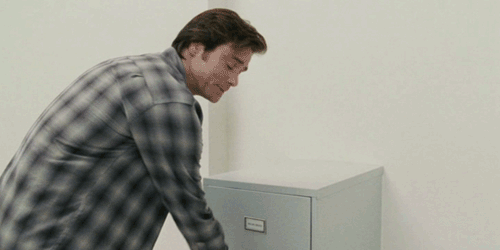
Why legacy contracts should be kept with new ones
First of all, it’s unsafe to store sensitive information in different places. Second, it’s inconvenient. Disorganization may lead to delays, as well as financial, reputational, and other risks. Here are a few reasons to keep all contracts in one location:
- Greater visibility for contracts, including legacy ones. They may have information you’ll need in the future, such as dates, terms, costs, and so on. Plus, you can’t manage documents you can’t see.
- Improved tracking. Information like when it was created, what was the sequence of particular contracts, whether there were any changes or addendums, and the reasoning for amendments becomes simpler to find as everything’s at hand.
- Less chance of missing contract renewals and obligations. Instead of checking deadlines (or, even worse, missing them) every chance you get, you can set reminders so that renewals and obligations are completed on time.
- Simpler for users to find them. You won’t have to dig through stacks of papers looking for an old contract when you need it. Contract lifecycle management solutions store documents in a contract repository. So long as the metadata is tagged correctly, you won’t have any problems accessing them.
- Quicker data retrieval for new contracts. It’s much faster than reentering data each time you’re preparing a contract. This helps automate contract lifecycle management systems to the level where preparing simple contracts takes less than a minute.
- Fewer gaps when tracking specific cases, records, and relationships with counterparties. There are always clients you have special relationships with, as well as specific terms and offers. It’s impossible to remember all the nuances, but you can check them ASAP.
- Increased awareness of team and contract performance. When everything’s structured, you don’t have to waste time searching and collecting information for analyses. You control the workflow.
How AXDRAFT helps
The main goal of any team managing contracts is to keep them and the data they contain at the ready.
AXDRAFT’s all-in-one CLM system covers the entire lifecycle while bringing all contract-related workflows into one place. The data you need is in the same system, making it easy to manage, retrieve, and report. You won’t have to copy-paste information you already have because CLM solutions can take care of it for you (and you get a contract free of errors!). This simplifies the whole contract lifecycle management process, reducing time spent on drafting, negotiating, and approving by up to 80%.
You can always choose not to migrate legacy contracts to your CLM system, but this approach risks wasting considerable time trying to locate them, extract data, track obligations, meet deadlines, and create analytical reports.
How to upload contracts to the platform
This might be the most important question when working with legacy contracts in AXDRAFT. To get them on AXDRAFT, you need to upload them. There are several ways to do this, and each has its specifics.
- Option 1: You can upload legacy contracts directly to your storage, which is where ALL documents are stored. Documents will be either .doc or .pdf, depending on the file’s format. As such, you’ll know they weren’t created within AXDRAFT, as AXDRAFT files are .AXD. Documents can be uploaded in bulk and with as many as you need.

- Option 2: External files can be uploaded to an existing project inside AXDRAFT. This part of storage is where contracts are divided by project and separated into folders. When opening a folder, you’ll see a list of all files (both native and uploaded) available in the project. However, you can upload only one file at a time with this method.
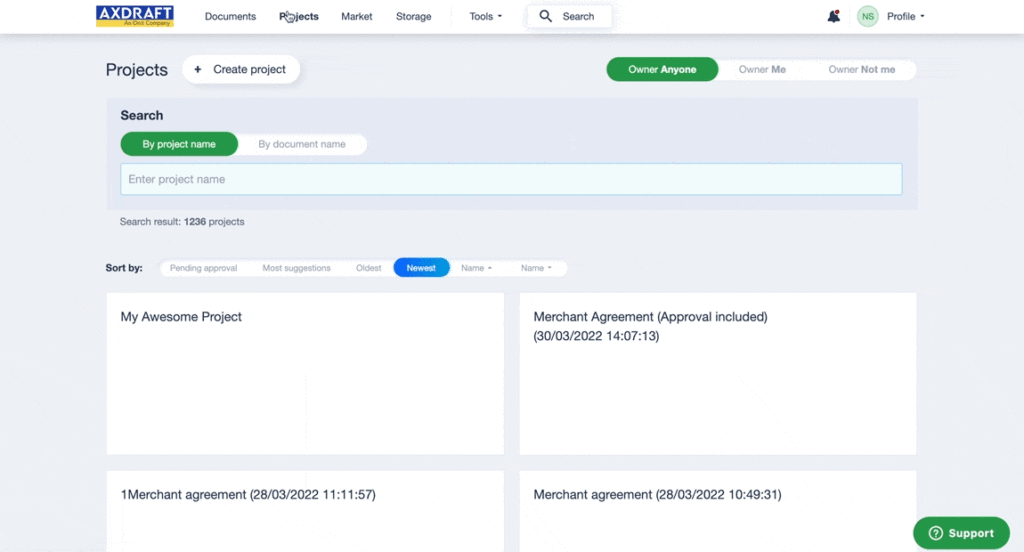
- Option 3: When you open a document, the screen you see already has Collaboration Mode enabled. It allows you to edit documents and attach files as .pdf, .docx, .xlsx, .msg, or .eml. This is important for big contracts containing additional information such as agreements, invoices, powers of attorney, etc. Files uploaded in this way are visible only when you open the document. To see their contents, you’ll need to download them.

How to find and manage data for legacy contracts
After uploading contracts to the platform, they remain available for further use. However, companies usually work with numerous contracts, and finding one among countless others may not be an easy task. To simplify the process, we use metadata.
The quick definition of metadata is that it’s data about data. It’s used to structure information so that it can be easily found, analyzed, calculated, and automated. Typically, metadata includes information about the date of creation, the author, the purpose of creation, the type, and the size. Whenever you enter a value inside a data input field, it’s saved as metadata.
- During or after uploading a contract, you can manually assign any amount of metadata to the contract’s data. This can also be done when you upload files to your storage. The CLM solution will prompt you to enter required information such as dates and names right after uploading.
- Thanks to metadata, you can easily find the contract that you’re looking for. Just set the filter and enter a date, name, contract type, or some other search criteria. For example, if you want to see the list of all contracts that were executed under California governing law in October 2022, adjust the filter to identify contracts related to California and October 2022. All matching native and legacy contracts will be aggregated.

- If you need to process multiple contracts at once, you can assign metadata in bulk to save time. Click on Bulk edit, select the right contracts, and update their metadata simultaneously.
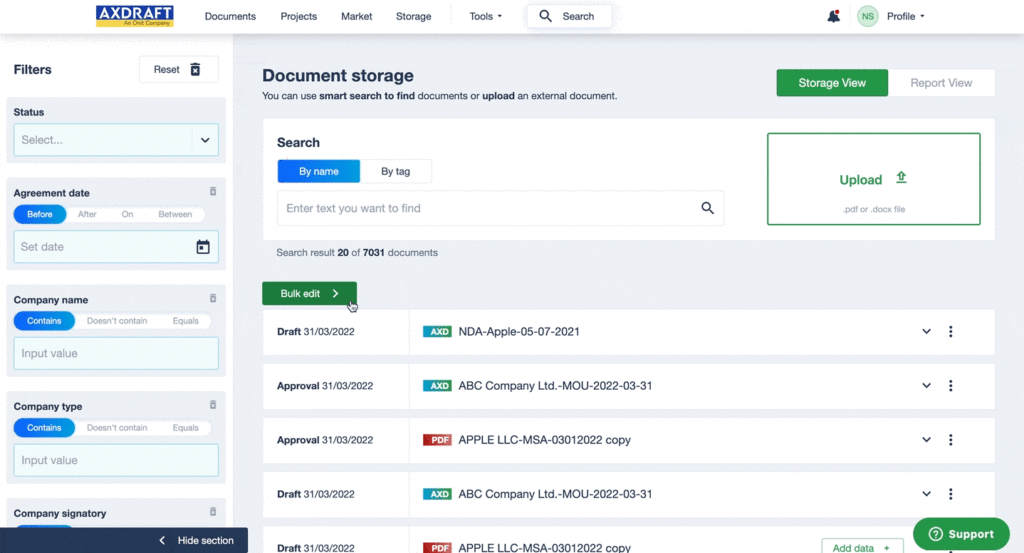
- You can specify the metadata that must be assigned to a legacy contract, and the AXDRAFT team will make it required. This way, any user uploading an external file to the platform will not be able to proceed without providing the necessary metadata.
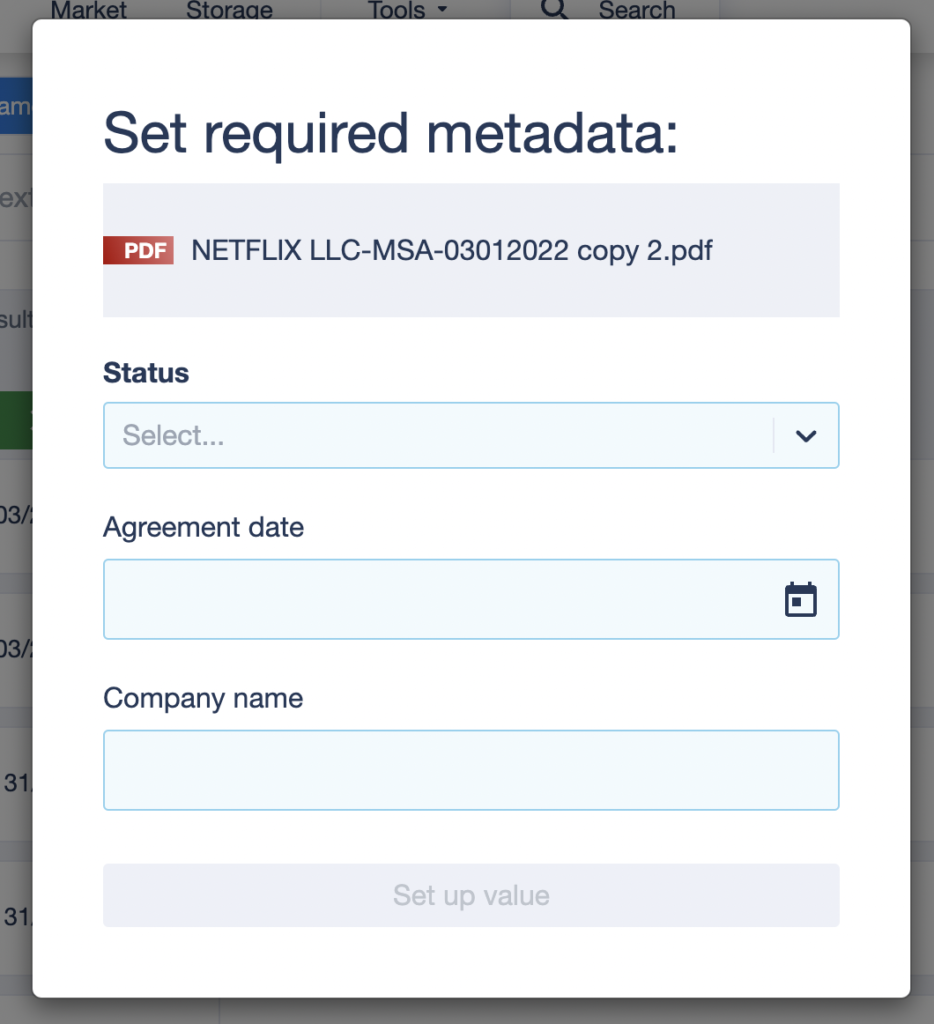
- Any contract data can be saved as metadata. And you can use any data to help you find the contracts you need. For example, it can be contact info, laws, terms, or something else. What’s more is that this data doesn’t even need to be in the document itself.
As we previously mentioned, all legacy contracts saved to the platform can be retrieved using AXDRAFT’s search capabilities. Search is possible not only by metadata, but by names, tags, or text. Here’s a brief overview of each one:
- Metadata: Any data you add to a contract as metadata can be used for searches. Enter the target data to existing filters or add yours on the left side of the screen.
- Name: When you search by name, it will show you all documents with the indicated name.
- Tags: Tags can be added to documents. When you’re looking for a document, you can search “by tags” and you’ll easily find all documents with the same tag.
- Text: When searching by text, you’ll need to enter an excerpt of text into the search box. The system will then show you all files that contain the same text.
These methods not only facilitate searches, but they can be used simultaneously.
Tracking obligations and analyzing performance
To help you avoid unwanted contract renewals and missed obligations, AXDRAFT lets you create custom tasks via a To-Do panel. You can save any date or clause, or leave yourself a task or memo.
At the bottom of the page, you’ll find the Reminders section. Click Create reminder, then enter the task, set the time, and input a date. Once a task is complete, you can mark it as done and it will disappear from the panel.
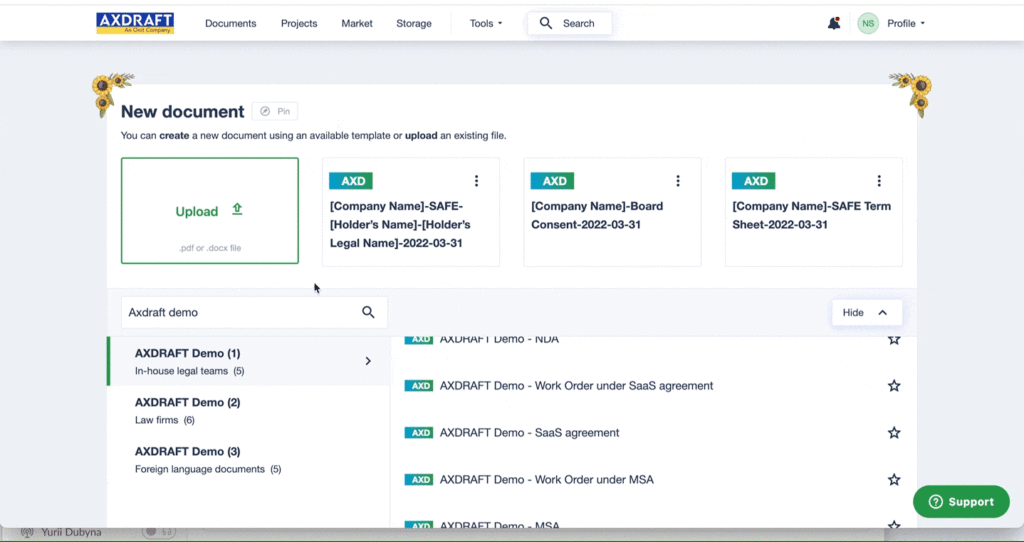
To analyze the performance of your contracts, or to factor legacy contracts into your overall analysis, AXDRAFT supports the ability to build custom reports. Any metadata from legacy contracts can be processed into tailored reports. This allows you to evaluate your business and team performance.
Custom reports are built via the Storage page. On this page, select Report view at the top, then set the date range and type of report. After that, you’ll need to set conditions. You can add as many conditions to your report as you need.
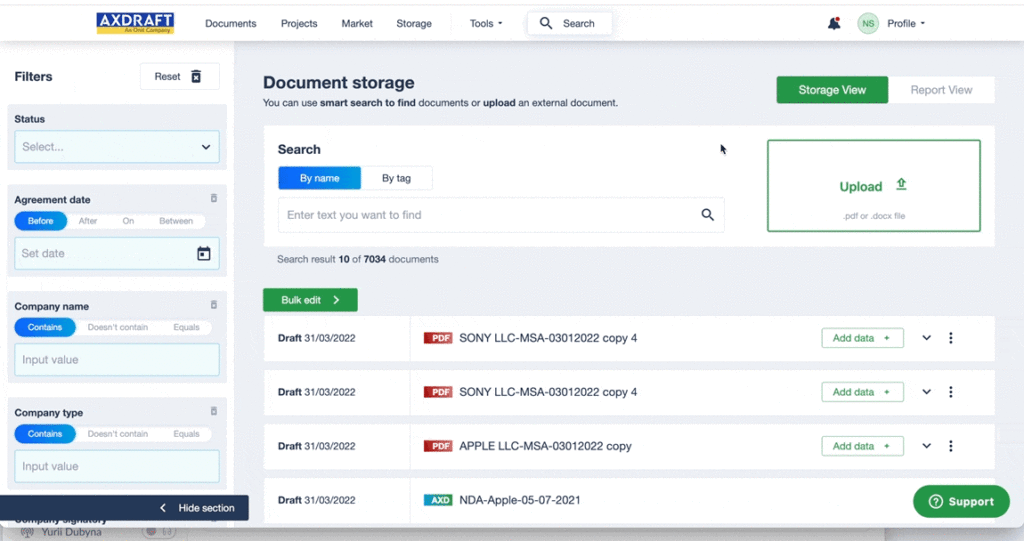
If you require physical copies of your contracts, or if you want to keep records for each of your contracts elsewhere, you can generate a Certificate of Approval. It will include a QR code that can open any contract in the system when scanned. Contracts will only be available to users who are logged in to AXDRAFT. This certificate shows the stages of approval, and it can be downloaded for documents that went through the approval flow.
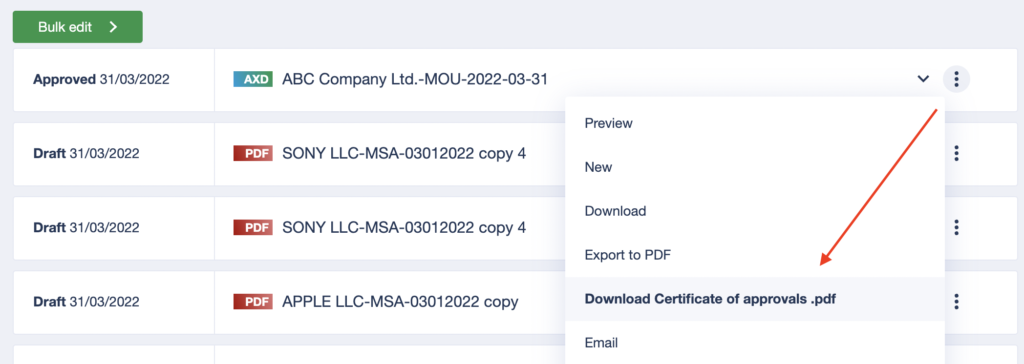
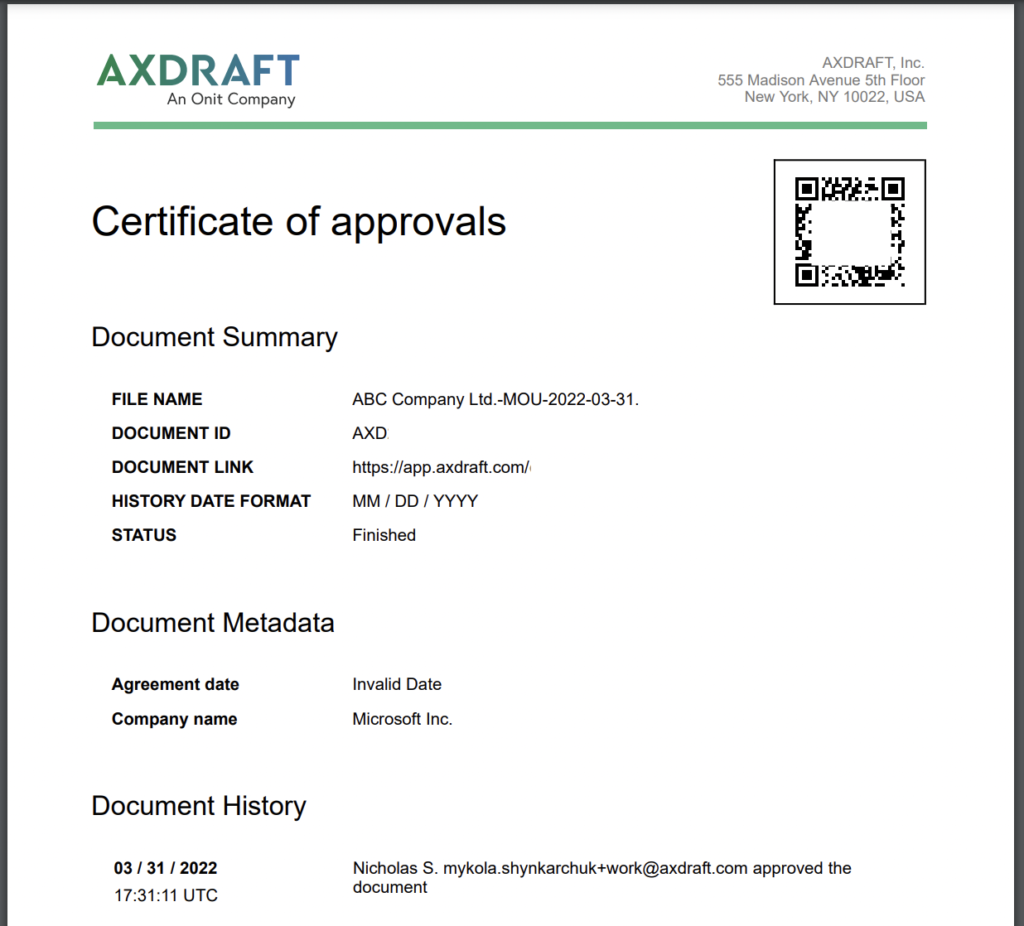
Wrapping up
Placing legacy contracts under the same roof as new ones makes contract-keeping convenient. They remain close at hand, and they’re easier to manage, analyze, and report. At AXDRAFT, we constantly strive towards enabling frictionless workflows for contracts that were created outside of our platform.
Companies are able to use AXDRAFT’s CLM system seamlessly because of its convenient nature and user-friendly interface. The platform already includes several essential integration options, and the team is always willing to build additional solutions on demand. If you’d like to see the workflows for legacy contracts in more detail, book a demo to get in touch.